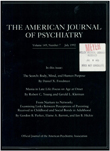Structured interviews for borderline personality disorder
Abstract
The authors compared three instruments used to diagnose borderline personality disorder--the Diagnostic Interview for Borderline Patients (DIB), the Schedule for Interviewing Borderlines, and the Structured Interview for DSM-III Personality Disorders--in 56 patients with personality disorders. A borderline diagnosis was made according to the DIB in 30%, the Structured Interview for DSM-III Personality Disorders in 48%, and the Schedule for Interviewing Borderlines in 55% of the patients. Diagnostic agreement was only 52%, which has implications for the generalizability of results of validation studies of the borderline diagnosis. Improvement in diagnostic agreement requires modification of current criteria sets and/or the use of dimensional models.
Access content
To read the fulltext, please use one of the options below to sign in or purchase access.- Personal login
- Institutional Login
- Sign in via OpenAthens
- Register for access
-
Please login/register if you wish to pair your device and check access availability.
Not a subscriber?
PsychiatryOnline subscription options offer access to the DSM-5 library, books, journals, CME, and patient resources. This all-in-one virtual library provides psychiatrists and mental health professionals with key resources for diagnosis, treatment, research, and professional development.
Need more help? PsychiatryOnline Customer Service may be reached by emailing [email protected] or by calling 800-368-5777 (in the U.S.) or 703-907-7322 (outside the U.S.).



